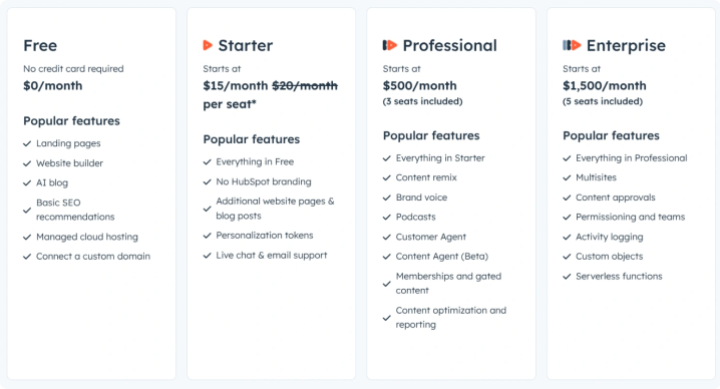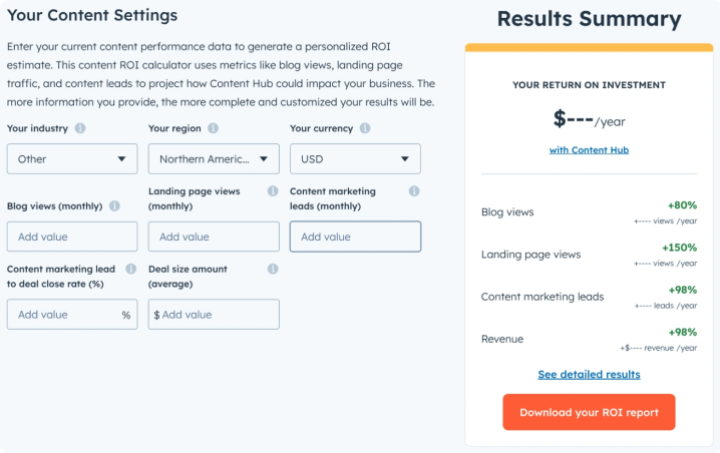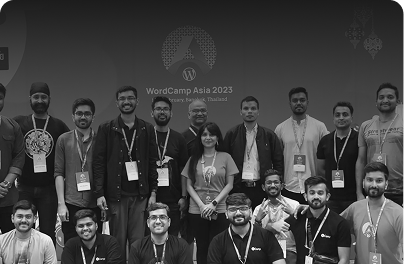HubSpot or WordPress? Comparing total cost of ownership for better value
When enterprise teams weigh HubSpot against WordPress, the discussion often starts with licensing fees or sticker prices.
HubSpot’s pricing is clear: it’s designed to keep marketing agile, with infrastructure, upgrades, security, and core functionality wrapped into predictable SaaS plans. That convenience has a real value, but the moment you step outside HubSpot’s ecosystem to add custom systems, integrations, or advanced workflows, you’re no longer just paying for the platform. You’re paying for specialized talent, API layers, middleware maintenance, and the trade-offs of operating inside a closed ecosystem.
WordPress flips this model on its head. The core software is free, you only pay for how you implement, host, and scale it. More importantly, it’s open and modular by design: there’s no vendor license tying you to a single stack. Your teams own the roadmap which might mean higher upfront investment, but more budget control, flexibility, and reuse over time and a much higher ROI over time.
In this chapter, we’ll unpack how those differences play out in real-world TCO.
HubSpot CMS vs WordPress: Licensing costs
At its core, HubSpot’s pricing model seems straightforward: for the Content Hub Enterprise plan, you pay $1500/month. So it appears like you pay one predictable fee, and your team is ready to launch campaigns. This plan supports up to 10,000 website pages and comes with strong features like HubSpot’s landing page builder, A/B testing, SEO recommendations, and more.
However, it includes only 5 user seats by default. Each additional seat is ~$75/month, reasonable until you scale to a large distributed marketing team, content editors, regional brand managers, and contractors. Large organizations routinely find themselves paying for dozens, sometimes hundreds of extra seats.
On top of that, usage caps apply across many features. While these limits may feel generous for smaller teams, they can quickly become restrictive as your operations scale. These constraints (and the associated costs) should be factored into any long-term planning.

If you’re considering a full HubSpot suite (not just the CMS) you’ll need to factor in the pricing for its other Hubs as well (like Marketing, Sales, or Service). HubSpot provides a handy pricing calculator to estimate this. (Note: We’re only referring to HubSpot’s product access costs here… services, implementation, and ongoing support are separate.)

With WordPress, this is quite different:
- No licensing fee for WordPress core (completely open-source).
- Enterprise-grade managed hosting (e.g., WordPress VIP) typically starts around $2000/month, including infrastructure, SLAs, security, and performance guarantees.
- You pay for the level of hosting, support, and service you need, costs are tied to traffic, not usage volume or feature unlocks.
As you can see, with WordPress, there’s no limit on the number of pages or users: you can scale your content and team without incurring per-seat or per-page costs. Whether you’re running 500 or 50,000 pages, the platform doesn’t enforce caps. User roles and permissions are fully configurable, and you can onboard as many editors, marketers, and developers as needed, at no additional licensing cost.
The only scaling factors that impact cost are infrastructure and support, such as hosting bandwidth or SLA tiers on platforms like WordPress VIP. This flexibility makes WordPress particularly well-suited for enterprises with large content operations and cross-functional teams.
HubSpot CMS vs WordPress: What proprietary vs open-source really costs
Beyond HubSpot’s simple subscription lies a more layered reality of the TCO once you look deeper at how HubSpot’s proprietary stack shapes real costs over time.
If you adopt HubSpot as your main CMS, you’re not just buying page templates and drag-and-drop editing. You’re committing to its database structure, its native HubL templating language, and its internal content modeling conventions. On paper, HubL gives you ways to build custom modules, dynamic page layouts, and reusable marketing components, but unlike PHP, Node, or React, HubL is a niche language with a limited developer talent pool.
This means even simple customizations can create talent constraints and premium costs. Many organizations find their existing engineering team can’t simply pick up HubSpot backend work without first investing in upskilling or they’re forced to bring in specialist HubSpot agencies that charge higher rates than standard web dev shops. What looks easy at the frontend UI can become costly when you hit the limits of what HubL can flexibly deliver.
WordPress’s stack ( PHP, MySQL, modern JavaScript, etc,) is familiar to millions of developers worldwide. The WordPress ecosystem is massive with an active community and high-quality agencies compete on expertise and value, not on monopoly over a proprietary solution. This keeps costs predictable and makes it far easier to find partners or in-house hires who can build, extend, and maintain your CMS without a steep learning curve.
HubSpot CMS vs WordPress: Hidden costs of integrations
Beyond developer resourcing, integration costs are the next hidden layer. HubSpot shines when you stay inside its HubSpot ecosystem. Its different solutions mesh neatly together.
But in real enterprise settings, marketing rarely lives in isolation, and HubSpot isn’t even a complete DXP. Sooner or later, you need to connect an external DAM, a legacy ERP, a modern CDP, or a custom eCommerce backend that HubSpot doesn’t natively support. At that point, you step outside HubSpot and your team now bears the burden of securing, maintaining, and monitoring custom API connectors, middleware layers, and embedded scripts. You’re responsible for data flow, versioning, authentication, and compliance, just as you would be with any open system, except you’re doing it in a stack you don’t fully control.
When it comes to WordPress, integration costs are often lower and more predictable too, even in enterprise settings. Because WordPress is built to plug into nearly any external system, you’re not forced to build workaround middleware every time you need to connect a DAM, CRM, or personalization engine. You can work with widely used APIs, off-the-shelf connectors, or tap a huge global pool of plugin resources to solve common enterprise use cases.
WordPress is your open, vendor-neutral DXP core that can sit inside any modern stack. You’re free to plug in the best CRM, CDP, DAM, or personalization tool for each function. If you want to swap out a layer, you can, without rewriting your CMS or getting locked into a single roadmap. This modularity means your content layer evolves at your pace and not at a vendor’s.
There’s more…
There’s yet another thing to consider when it comes to the HubSpot vs WordPress TCO analysis: the cost of moving away.
So the deeper you build inside HubSpot, the more tightly coupled your business logic becomes to its proprietary way of working.
If your needs evolve, say you want to migrate to a headless stack or switch to a more open CMS to gain deeper backend control, you don’t just lift-and-shift your content. You have to untangle HubL templates, transform proprietary modules, and rewrite them in standard languages like PHP or JavaScript. For large sites, this exit work is never trivial, it’s an expensive, time-consuming project that teams often underestimate when calculating TCO.
For WordPress, migration risk stays minimal. If you ever need to move from WordPress, your content is your database. Your templates use standard languages. Your integrations follow standard patterns. You’re never trapped inside a closed architecture you can’t control.
Talent costs: the hidden driver of long-term TCO
On paper, HubSpot’s Content Hub feels refreshingly simple, especially for non-technical marketing teams. Everything is integrated, the UI is famously user-friendly, and you can launch new pages fast. But under the hood, its proprietary nature means you’re tied to HubSpot’s own ecosystem and tools.
For example, HubSpot’s templating language, HubL, isn’t PHP or React or any other mainstream framework, it’s unique to HubSpot. The same goes for HubDB and the way HubSpot structures content relationships. So the moment your team wants to build anything beyond standard landing pages (dynamic content, custom modules, advanced personalization) you need developers fluent in HubSpot’s specific stack.
That might not sound like a problem until you start hiring. HubSpot specialists are a niche market. You can’t always redeploy your in-house PHP or JS teams, they’ll need to retrain or you’ll pay a premium for contractors or agencies who do speak HubSpot fluently. Fewer qualified professionals means higher hourly rates, longer onboarding, and reduced leverage when negotiating support retainers. And because it’s a closed system, you can’t easily “outsource” parts of the work to your internal devs or other partners without getting them up to speed on HubSpot’s way of doing things.
WordPress, in contrast, is built on open web standards: PHP, MySQL, REST APIs, GraphQL (via WPGraphQL), standard JS frameworks for front-end decoupling, all technologies millions of developers already know.
This means when you want to extend WordPress (custom code, plugins, new templates, headless front-ends, API integrations, etc.), you can tap into the largest talent pool in the CMS world. From internal engineering teams to global agency partners, you’re never locked into a small niche of high-cost specialists.
The same freedom applies to your choice of partners: because WordPress is so widely used, you can find development, design, security, and support agencies that specialize in enterprise WordPress, often at more competitive rates than you’d find for niche HubSpot shops.
TL;DR: The long-term HubSpot vs WordPress TCO scenario
Here’s what your TCO snapshot would look like in a couple years with both CMSs:
| Platform | Year 1 TCO | Year 3 TCO | Scaling cost drivers | Flexibility ROI |
| HubSpot | $$ | $$$$$ | Contact volume, API usage, seats | Fast start, limited depth |
| WordPress | $$$ | $$$ | Infra, dev time (predictable) | Custom stack, full control |
HubSpot vs WordPress: Which is the more cost-effective CMS?
On paper, HubSpot’s pricing looks straightforward: one SaaS subscription to cover your CMS.
But as you grow, costs add up quickly. You’re looking at usage tiers, seat licenses, specialized HubL developers, paid add-ons, and costly integrations for anything that lives outside HubSpot.
WordPress, by contrast, keeps your budget where it belongs: building what you actually need. There’s no core licensing cost. You’re free to choose solutions that offer the best value and not just those that your CMS vendor happens to offer. Your teams work in common, widely supported technologies, so you’re never paying a premium for niche talent or getting boxed in by a proprietary stack. You own your platform, your data, your integrations, and the savings actually compound as you scale.
For enterprises that think in multi-year TCO, there’s no contest, WordPress gives you better ROI.







